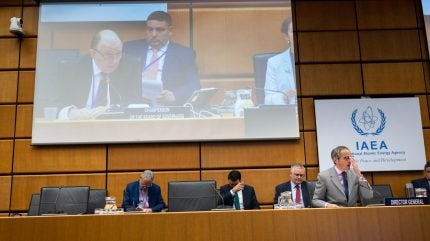
Russia and Ukraine have exchanged blame over a spate of recent attacks on the Russian-occupied Zaporizhzhia Nuclear Power Plant (ZNPP), sparking concerns over mass radiological contamination should drones breach the reactors at Europe’s largest nuclear site.
“Reckless attacks” on Russia-occupied Zaporizhzhia in eastern Ukraine “significantly increase the risk of a major nuclear accident”, Rafael Mariano Grossi, director-general of the International Atomic Energy Agency (IAEA), told the UN Security Council on Monday (15 April).
The IAEA sounded the alarm after a series of drone strikes on the ZNPP since 7 April, the first since November 2022. There was one reported casualty.
Spread over several days, the attacks damaged the roof of ZNPP’s Reactor 6, adjacent to the main reactor buildings.
All six reactors were promptly moved into a state of cold shutdown – but there is still a risk of reactor meltdown should shells or drones breach the concrete walls encasing each.
Whodunnit?
Russia and Ukraine have accused each other of carrying out the attacks on Zaporizhzhia.
Moscow accused Kyiv of “very dangerous” attacks on ZNPP, while Ukraine’s President Volodymyr Zelensky said Russia would undertake a “terrorist attack” at the plant, which it has taken “hostage”.
UN nuclear watchdog the IAEA, meanwhile, has not said who it believes is behind it.
The Kremlin has extensively targeted Ukraine’s energy grid in recent months, resulting in mass power outages across Odesa, Mykolaiv and other oblasts.
Despite Russia’s previous form, the likeliest culprit behind Zaporizhzhia seems to be carelessness and equipment malfunction.
Drones are susceptible to jamming, spoofing, crashing or just losing communication and falling out of the sky.
Zelensky has also described Russia’s occupation of ZNPP as “radiation blackmail”, a term first coined as ‘atomic blackmail’ at the height of the Cold War in 1985 by foreign policy and nuclear expert Bennett Ramberg.
By bombing nuclear power plants of a neighbouring state, the aggressor nation risks poisoning its own soldiers, civilians and land.
It can render large swathes of land uninhabitable, creating a radiological weapon should a reactor containment be breached by ballistic or cruise missiles.
In other words, there is next to no benefit for either Russia or Ukraine – and in one of the world’s most monitored airspaces, third-party sabotage is highly unlikely.
More severe radiation than Chernobyl?
Some analysts – and workers at the Zaporizhzhia site – have warned that the levels of radioactive pollution should a reactor be breached would be “worse than Chernobyl”, Sky News reported.
The 1986 Chernobyl disaster released radionuclides which contaminated farmland across Europe, forcing 350,000 people to flee their homes, albeit not because of a military strike.
Others have said such alarm is catastrophised.
The risk of shelling is limited by the ten-metre-thick concrete walls protecting ZNPP’s reactors, POLITICO reported.
Unlike Chernobyl, Zaporizhzhia uses pressurised water reactors, requiring less uranium fuel in the reactor core and reducing the risk of a (toxic and flammable) chain reaction.
But the ramifications of a reactor breach remain severe.
Chernobyl only had four nuclear reactors; Zaporizhzhia boasts six. Neither plant was designed to withstand military-grade drones.
Any nuclear accident would have “significant radiological consequences”, in Grossi’s words, as well as potentially causing massive energy deficits across Europe.
Such high stakes are expected to prompt the IAEA and other UN agencies to make further calls for restraint in the Zaporizhzhia area, to both Russia and Ukraine.



